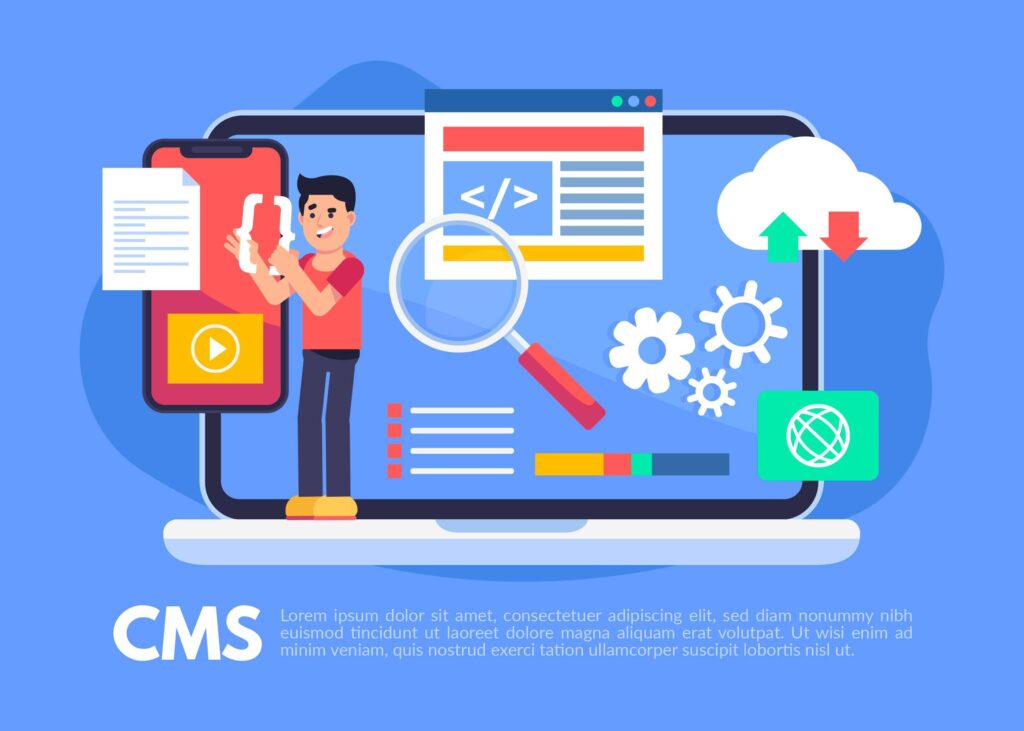Looking for a scalable, secure, and cloud-native solution to manage enterprise content? The Microsoft Azure content management system ecosystem offers just that — a flexible foundation for businesses that need more than a basic CMS.
In today’s fast-paced digital landscape, companies need to manage massive volumes of content across web, mobile, and internal systems. Microsoft Azure doesn’t just offer hosting; it powers an entire ecosystem of CMS platforms optimized for performance, compliance, and global reach. Whether you’re building a headless solution, migrating from legacy systems, or seeking deeper integration with Microsoft 365 and Dynamics, Azure gives you the infrastructure and flexibility to scale with confidence.
But how exactly does it work — and which CMS platforms run best on Azure?
Let’s explore what makes Azure a leading choice for content-driven enterprises.
What Is Azure?
Microsoft Azure is a cloud computing platform and service developed by Microsoft. It provides a wide range of cloud-based tools and infrastructure that businesses can use to build, host, manage, and scale applications — including content management systems (CMS).
Think of Azure as the backbone for digital transformation. Instead of running servers or software on your own hardware, Azure lets you run them in the cloud — with on-demand performance, global availability, built-in security, and seamless integration with Microsoft products like Office 365, SharePoint, and Dynamics 365.
Core capabilities of Azure include:
- Virtual machines and cloud hosting for web apps and CMS platforms
- AI, machine learning, and analytics tools for content insights
- Storage and databases for digital assets and user data
- Security and compliance at an enterprise level
- DevOps tools and APIs to support agile development and content delivery pipelines
When it comes to content management, Azure isn’t a CMS itself — but it’s a powerful platform to run and scale any CMS that fits your needs, from headless systems like Contentful to enterprise suites like Sitecore or custom-built .NET solutions.
Microsoft azure content management system

A Microsoft Azure content management system isn’t a single product — it’s a flexible, cloud-based ecosystem where organizations can host, deploy, and scale CMS platforms of their choice, backed by Microsoft’s global infrastructure.
Instead of relying on a traditional CMS tied to limited on-premises resources, Azure allows you to run headless CMS platforms, traditional web CMSs, or fully custom-built systems — all while benefiting from Azure’s scalability, security, and native integration with Microsoft services.
What Makes Azure a Smart CMS Hosting Platform?
- Enterprise-Grade Security
Azure offers multi-layered protection, compliance with global standards (like GDPR and HIPAA), and built-in identity management through Azure Active Directory. - Seamless Microsoft Ecosystem Integration
Azure connects effortlessly with Microsoft 365, SharePoint, Power Platform, Dynamics 365, and Teams — ideal for organizations already using Microsoft tools. - Flexible CMS Deployment
Whether you’re using Sitecore, Umbraco, Kentico, Contentful, or even a custom .NET CMS, Azure supports containerization (via Kubernetes), serverless hosting, or virtual machines. - Scalable & Global
Azure’s global data centers and content delivery network (CDN) ensure fast, consistent performance — even across multilingual, multi-region websites. - Built for Developers and Content Teams
Azure supports DevOps workflows, CI/CD pipelines, and headless architecture — empowering tech teams to build and launch faster, while giving content teams intuitive tools for publishing and collaboration.
Use Case Examples:
- A global brand running Sitecore on Azure PaaS to manage multilingual campaigns
- A media company using Contentful + Azure Functions for headless delivery across web and mobile
- An enterprise migrating from legacy SharePoint to a modern CMS hosted on Azure
In short, Microsoft Azure content management systems give enterprises the agility to manage content at scale — without sacrificing control, security, or integration.
Read:
Benefits of Using Azure and Azure Software
Choosing a Microsoft Azure content management system means you’re not just selecting a place to host your content — you’re investing in a powerful, secure, and integrated ecosystem built for long-term growth. Here are the top advantages of using Azure and its related software for enterprise content management:
1. Scalability on Demand
Azure’s cloud infrastructure allows your CMS to scale automatically based on user traffic, content size, or seasonal demand. No more worrying about server capacity during product launches, global campaigns, or sudden traffic spikes.
2. Enterprise-Grade Security & Compliance
Microsoft Azure is trusted by governments, banks, and Fortune 500 companies. It includes:
- Built-in threat detection and data encryption
- Support for compliance standards like GDPR, ISO 27001, HIPAA, and FedRAMP
- Identity and access control via Azure Active Directory
3. Seamless Integration with Microsoft Products
If your organization already uses Microsoft 365, Teams, SharePoint, or Dynamics 365, Azure offers native integration that simplifies workflows and boosts productivity across departments.
4. Support for Modern CMS Architectures
Azure supports:
- Headless CMS platforms (like Contentful, Strapi, or Sanity)
- Traditional web CMS (like Sitecore, Kentico, or Umbraco)
- Custom .NET or JavaScript-based CMS solutions
This gives your dev team full control over how content is structured, delivered, and updated.
5. Global Reach with Low Latency
With over 60+ Azure regions worldwide, your content is delivered faster and more reliably to users in any geography — thanks to Azure CDN and traffic management tools.
6. High Availability & Disaster Recovery
Azure offers built-in redundancy, backup, and recovery options. This means your content is safe, and your site stays online — even during outages or system failures.
7. DevOps and Automation Support
Azure makes it easy to manage infrastructure as code, set up CI/CD pipelines, and automate deployment and testing — speeding up CMS updates and reducing human error.
8. Advanced Analytics and AI Capabilities
With Azure AI, Cognitive Services, and Power BI, you can extract insights from your content, personalize user experiences, or automate tagging and translations.
Why Use Azure Hosting Instead of AWS or GCP?
When evaluating cloud providers for a content management system, the top three options usually come down to Microsoft Azure, Amazon Web Services (AWS), and Google Cloud Platform (GCP). Each offers cloud hosting, storage, and scalability — but Azure delivers distinct advantages, especially for content-focused enterprises already invested in the Microsoft ecosystem.
Here’s why many organizations choose Azure over AWS or GCP for CMS hosting:
1. Tighter Integration with Microsoft Products
Azure is the only cloud platform that seamlessly integrates with Microsoft 365, SharePoint, Teams, Active Directory, and Dynamics 365. If your organization already uses Microsoft tools for collaboration, CRM, or security, Azure enables faster setup and more cohesive workflows — no complex middleware or workarounds.
2. Better Support for .NET and Windows-Based CMS Platforms
Azure was built by Microsoft — so it naturally offers the best support for .NET applications, including CMS platforms like Sitecore, Umbraco, and Kentico. While AWS and GCP can run these apps, Azure offers native tools, optimized performance, and easier management for Windows-based workloads.
3. Stronger Enterprise Identity Management
Azure Active Directory (AAD) provides built-in identity and access control across all services — ideal for managing user permissions in large teams. While AWS has IAM and GCP has Cloud Identity, AAD is often seen as more enterprise-ready, especially for organizations with existing Microsoft user bases.
4. Global Reach and Hybrid Cloud Leadership
Azure offers one of the largest cloud networks globally, with 60+ regions and a strong focus on hybrid cloud solutions. If you’re migrating from on-prem systems or need to blend cloud + local hosting (e.g., in healthcare or government), Azure is often better equipped than AWS or GCP.
5. Simplified Licensing and Cost for Microsoft-Centric Teams
With Azure Hybrid Benefit, businesses can reuse existing Windows Server and SQL Server licenses — reducing overall cost. Microsoft also offers bundled pricing that combines Azure services with Microsoft 365 or Dynamics subscriptions, which AWS and GCP don’t match.
6. Built-In AI, Analytics, and Cognitive Services
Azure includes advanced tools like Cognitive Search, Language Understanding (LUIS), and Power BI, helping CMS platforms deliver smarter content experiences, personalized search, and deeper insights — without external vendors.
Summary:
Choose AWS if you’re deeply invested in open-source or require broad service variety.
Choose GCP for AI-heavy, developer-first workloads.
But choose Azure if you want:
- Seamless Microsoft product integration
- Native .NET and Windows CMS support
- Enterprise identity management
- A hybrid-ready cloud architecture
Also read:
What is the purpose of Azure CDN?
The Azure Content Delivery Network (CDN) is a global caching service that helps deliver web content — like images, videos, scripts, stylesheets, and CMS assets — faster and more reliably to users around the world.
When you run a Microsoft Azure content management system, the CDN plays a crucial role in improving website performance, especially for content-heavy sites or global audiences.
Key purposes of Azure CDN:
1. Faster Content Delivery
Azure CDN stores copies of your content on strategically located servers (called edge nodes) around the world. When a user visits your website, content is served from the nearest node — reducing latency and page load times.
2. Improved Website Performance and User Experience
Slow-loading content affects bounce rates, SEO, and conversions. Azure CDN helps maintain a fast, smooth experience, even during high traffic or peak times.
3. Reduced Load on Origin Servers
Instead of every request going to your core CMS infrastructure, the CDN handles most of the traffic — lowering bandwidth costs and server strain.
4. High Availability and Resilience
If one data center experiences issues, the CDN can continue serving content from other nodes. This ensures your CMS stays available, even during network disruptions.
5. Scalability for Global Reach
Azure CDN is especially useful for multinational companies running multi-region or multilingual CMS platforms. Content is delivered consistently, regardless of the user’s location.
6. Secure Content Delivery
Azure CDN supports HTTPS, token authentication, geo-filtering, and custom domain integration — keeping your content secure while in transit.
Is Azure Sentinel a sIEM or a soar?
Microsoft Azure Sentinel is both a SIEM (Security Information and Event Management) and a SOAR (Security Orchestration, Automation, and Response) solution — integrated into a single cloud-native platform.
As a SIEM:
Azure Sentinel collects and analyzes security data across your entire digital estate — including logs, user activity, devices, applications, and cloud environments.
Key SIEM capabilities:
- Real-time threat detection
- Centralized log aggregation
- Correlation and alerting across Microsoft and third-party systems
- Machine learning-driven anomaly detection
As a SOAR:
Azure Sentinel also enables automated responses to threats through playbooks and incident response workflows using Azure Logic Apps.
Key SOAR capabilities:
- Automated threat investigation
- Response actions (block users, isolate endpoints, disable accounts)
- Integration with third-party tools (e.g., ServiceNow, Jira, Slack)
- Custom playbooks for rapid incident response
Summary:
Azure Sentinel = SIEM + SOAR
It’s a unified, cloud-native solution designed to help security teams detect, investigate, and respond to threats at scale — with automation and AI built in.
Is Azure CDN free?
No, Azure CDN is not free — but it does offer pay-as-you-go pricing with no upfront costs or long-term commitments.
Microsoft charges for Azure CDN based on:
- Data transfer (outbound traffic)
- Requests (HTTP/HTTPS)
- Rules engine usage (if applied for advanced behaviors)
- Regional pricing (North America, Europe, Asia, etc.)
While there’s no free tier specifically for Azure CDN, new Azure customers may receive free credits ($200+ depending on region) which can temporarily be applied to CDN usage.
Example Costs (as of 2025, estimated):
- Data Transfer: Starting from ~$0.081 per GB (first 10 TB/month)
- Requests: ~$0.0075 per 10,000 requests
- Rules Engine: Additional cost if used
Prices vary depending on the CDN provider you select within Azure (e.g., Verizon, Akamai, or Microsoft standard).
FAQ
What is a Microsoft Azure content management system?
It refers to any CMS platform (like Sitecore, Umbraco, Contentful, or a custom .NET solution) that is hosted or deployed on Microsoft Azure. Azure provides the infrastructure, security, and scalability — while the CMS handles content creation, management, and delivery.
Is Azure a CMS?
No. Microsoft Azure is not a CMS itself — it’s a cloud platform that hosts CMS software. You can use Azure to run headless CMS solutions, web CMS platforms, or fully customized content systems.
Is Azure Sentinel a SIEM or a SOAR?
Both. Azure Sentinel combines SIEM (Security Information and Event Management) for monitoring and threat detection, and SOAR (Security Orchestration, Automation, and Response) for automating incident response workflows.
What is the purpose of Azure CDN?
Azure CDN delivers content (images, videos, scripts, etc.) faster to global users by caching assets on edge servers. It improves load times, reduces server strain, and ensures faster content delivery — essential for performance-heavy CMS platforms.
Is Azure CDN free?
No, Azure CDN is a paid service. It uses pay-as-you-go pricing based on data transfer and request volume. However, new Azure users may receive initial free credits that can be applied toward usage.
Which CMS platforms work best with Azure?
Some of the most Azure-friendly CMS platforms include:
- Sitecore (PaaS-ready, .NET-based)
- Umbraco (open-source, lightweight .NET CMS)
- Kentico (enterprise-grade, .NET)
- Contentful or Strapi (for headless architecture)
- Custom-built solutions using .NET Core, JavaScript, or Node.js
Why choose Azure over AWS or GCP for CMS hosting?
Azure offers deeper integration with Microsoft 365, Active Directory, and Windows-based CMS platforms. It’s ideal for organizations already using Microsoft tools, needing hybrid cloud options, or deploying .NET-based systems.
Conclusion
In today’s digital-first world, managing content effectively at scale requires more than just a CMS — it requires a reliable, secure, and flexible foundation. That’s exactly what the Microsoft Azure content management system ecosystem provides.
With native support for .NET platforms, seamless integration with Microsoft 365, global scalability, and enterprise-grade security, Azure empowers businesses to build and run content systems that are fast, resilient, and future-ready.
Whether you’re deploying a headless CMS, migrating from legacy infrastructure, or building a multi-region content hub — Azure offers the tools, performance, and support to do it right.
If your team is already embedded in the Microsoft ecosystem or planning a large-scale digital transformation, Azure is more than a smart choice — it’s a strategic advantage.
Ready to get started?
Evaluate your CMS options, explore Azure’s PaaS capabilities, or consult with your IT team to align infrastructure with long-term content goals.


